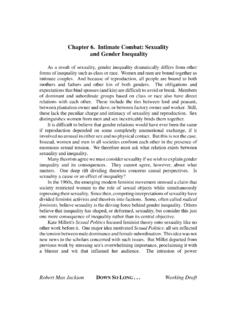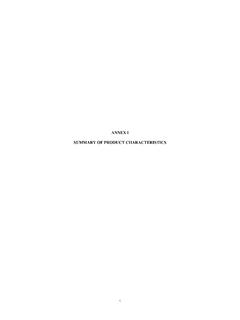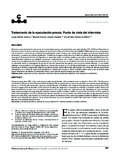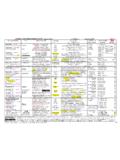Transcription of FIMS Position Statement: June 2000
1 F D RATION INTERNATIONALE DE M DECINE DU SPORT / THE INTERNATIONAL FEDERATION OF SPORTS MEDICINE Available on the FIMS web site: FIMS Position Statement: june 2000 The Female Athlete Triad A statement for health professionals from the Scientific Commission of the International Federation of Sports Medicine (FIMS) INTRODUCTION It is generally accepted that regular physical activity is important for health in females and males. For this reason, physical fitness programs for women should be recommended and encouraged all over the world (22). The gender-specific physiological, anatomical, psychological, and social aspects of the female athlete, however, need specific consideration in all levels of women sport.
2 Since the death of gymnast Christy Henrich from anorexia in 1994 at the age of 22 and a weight of 64 pounds or 29 kg, athletes, parents, coaches, medical personnel, judges, sport federations and sport governing bodies have become more aware of the medical and psychological conditions that can afflict young women participating in competition sport (35, 41). Of particular concern is the "Female Athlete Triad" of Disordered Eating, Amenorrhea and Osteoporosis. DEFINITIONS AND BASICS OF EATING DISORDERS, MENSTRUAL DYSFUNCTION AND OSTEOPOROSIS The "Female Athlete Triad" was described in 1992 by the Women's Task Force of the American College of Sports Medicine (53).
3 It refers to the inter-relatedness of three discrete medical entities that can occur in the female athlete population: disordered eating, menstrual dysfunction and premature osteoporosis. Individuals with one of the triad disorders are at risk and should be screened for the others. Eating disorders and disordered eating Eating disorders encompasses a number of abnormal eating patterns, including Anorexia Nervosa and Bulimia Nervosa. The latter two psychological conditions have strict criteria, as defined by the American Psychiatric Association (3). These must all be satisfied in order to make the diagnosis. Anorexia Nervosa Refusal to maintain body weight at or above a minimally normal weight for age and height ( weight loss leading to maintenance of body weight less than 85 % of that expected; or failure to make expected weight gain during period of growth, leading to body weight less than 85 % of that expected).
4 F D RATION INTERNATIONALE DE M DECINE DU SPORT / THE INTERNATIONAL FEDERATION OF SPORTS MEDICINE Available on the FIMS web site: Intense fear of gaining weight or becoming fat, even though underweight. Disturbance in the way in which one's body weight or shape is experienced, undue influence of body weight or shape on self-evaluation, or denial of the seriousness of the current low body weight. In post-menarchal females, amenorrhea, the absence of at least three consecutive menstrual cycles. Specify types Restricting type: During the episode of anorexia nervosa, the person does not regularly engage in binge eating or purging behaviour ( , self-induced vomiting or the misuse of laxatives or diuretics).
5 Binge eating/purging type: During this episode of anorexia nervosa, the person regularly engages in binge eating or purging behaviour (as defined above). Bulimia Nervosa Recurrent episodes of binge eating, characterized by both of the following: 1. Eating in a discrete period of time ( , within any 2-hour period) an amount of food that is definitely larger than most people would eat during a similar period of time and under similar circumstances. 2. A sense of lack of control over eating during the episode ( a feeling that one cannot stop eating or control what or how much one is eating). Recurrent inappropriate compensatory behaviour in order to prevent weight gain, such as self-induced vomiting; misuse of laxatives, diuretics, enemas, or other medications; fasting; or excessive exercise.
6 The binge eating and inappropriate compensatory behaviours both occur, on average, at least twice a week for 3 months. Self-evaluation is unduly influenced by body shape and weight. The disturbance does not occur exclusively during episodes of anorexia nervosa. Specify types Purging type: The person regularly engages in self-induced vomiting or the misuse of laxatives or diuretics. Nonpurging type: The person uses other inappropriate compensatory behavior, such as fasting or F D RATION INTERNATIONALE DE M DECINE DU SPORT / THE INTERNATIONAL FEDERATION OF SPORTS MEDICINE Available on the FIMS web site: excessive exercise, but does not regularly engage in self-induced vomiting or misuse of laxatives or diuretics.
7 A separate category of Eating Disorders Not Otherwise Specified (EDNOS) covers the wider variety of conditions that do not conform completely to the above definitions of anorexia and bulimia. It is important to recognize, however, that there is a spectrum of disordered eating, ranging from preoccupation with food, body size, shape and composition, to the more severe eating disorders. At any point along the continuum, there can be serious health implications. Nutritional deficiency, insufficient caloric intake for the amount of training and competition can result in an energy deficit, which in turn can lead to the other triad conditions: amenorrhea and osteoporosis.
8 Prevalence of eating disorders among athletes Female athletes have a higher risk for the development of eating disorders compared to male athletes (47). Anorexia nervosa, bulimia nervosa and eating disorders not otherwise specified occur more often in female and male athletes compared to non-athletes (47, 48). Furthermore, eating disorders occur more often in female athletes of esthetical sports and sports with weight-classes, compared to sports where weight is not thought to be important for a good result. Factors associated with eating disorders in athletes Eating disorders may have many causes. Due to the additional stresses in the surroundings of athletes, top-level sport women seem to be more susceptible to the development of eating disorders compared to female non-athletes (48, 50).
9 The factors associated with eating disorders in athletes include: 1. Caloric deficiency: A sudden increase in training volume might induce a caloric deficit. This deficit might be associated with biological and social consequences and end up in eating disorders (47). 2. Beginning of sport-specific training before puberty: Athletes with eating disorders started their career at an earlier age compared to athletes without eating disorders (47). If an athlete starts a sport-specific training before puberty, growth spurt and body development might lead to a body shape that is not ideal for the selected sport. This discrepancy might end in the attempt to change body shape by food restriction.
10 3. Traumatical experiences: Traumatical experiences for athletes may be the loss or changing of a trainer or an injury or illness, that do not allow normal training. This might lead to weight gain F D RATION INTERNATIONALE DE M DECINE DU SPORT / THE INTERNATIONAL FEDERATION OF SPORTS MEDICINE Available on the FIMS web site: and, in some cases, to an irrational fear of getting fat, and subsequently in dieting behavior in order to compensate reduction of energy expenditure (50). Other traumatical experiences that are associated with the development of eating disorders in athletes are longer lasting phases of diets, a casual comment (on body shape etc.)







